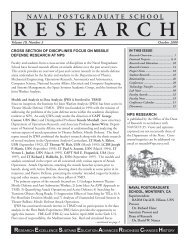Spectral Unmixing Applied to Desert Soils for the - Naval ...
Spectral Unmixing Applied to Desert Soils for the - Naval ...
Spectral Unmixing Applied to Desert Soils for the - Naval ...
Create successful ePaper yourself
Turn your PDF publications into a flip-book with our unique Google optimized e-Paper software.
also be seen in Figure 23. The leveling off of <strong>the</strong> pixel purity index curve at<br />
approximately 2000–3000 pixels is <strong>the</strong> basis that determines <strong>the</strong> maximum number of<br />
pixels <strong>to</strong> be used in <strong>the</strong> visualization step. To be sure that <strong>the</strong> best subset possible was<br />
used, 3000 pixels were set <strong>for</strong> <strong>the</strong> maximum. Once <strong>the</strong> purest pixels were identified and<br />
previewed, <strong>the</strong>y were <strong>the</strong>n extracted as endmembers.<br />
Two options <strong>for</strong> endmember extraction are possible, <strong>the</strong> first is imagery<br />
derived endmembers, which intuitively means that <strong>the</strong> endmembers are extracted from<br />
<strong>the</strong> imagery itself and is generally thought of as <strong>the</strong> best option (Kruse and Boardman,<br />
2011, Kruse and Perry, 2009). The second option is <strong>to</strong> input user supplied endmembers,<br />
which means one can input field or labora<strong>to</strong>ry collected spectra in<strong>to</strong> <strong>the</strong> algorithm and try<br />
<strong>to</strong> detect those as target material. Both options were run on <strong>the</strong> two data sets with <strong>the</strong><br />
highest spatial resolution <strong>for</strong> <strong>the</strong> Canyonlands site. The data sets were AVIRIS flight<br />
logs f110512t01p00r07 and f110512t01p00r08 with 2.9 m and 3.3 m spatial resolution,<br />
respectively. In some cases a third data set with 15.2 m resolution was utilized<br />
(f110623t01p00r10). This was done <strong>for</strong> two reasons; <strong>the</strong> first is because <strong>the</strong> BSC<br />
component does not necessarily take up large areas and <strong>the</strong> bigger <strong>the</strong> pixel, <strong>the</strong> less<br />
likely it is that BSCs will be detectable in <strong>the</strong> imagery. To test how <strong>the</strong> BSCs and o<strong>the</strong>r<br />
endmembers might be distributed in <strong>the</strong> imagery, <strong>the</strong>y were compared <strong>to</strong> <strong>the</strong> results using<br />
imagery derived endmembers. The second reason it was run on two data sets was <strong>for</strong> a<br />
repeatability test with <strong>the</strong> same endmembers at <strong>the</strong> same success rate. To try and create<br />
<strong>the</strong> most similar conditions, <strong>the</strong> data sets with <strong>the</strong> most similar spatial resolution and<br />
<strong>to</strong>pography were selected; <strong>the</strong> third data set was used when fur<strong>the</strong>r testing was required.<br />
Figure 24 shows some of <strong>the</strong> 48 endmembers derived from <strong>the</strong> imagery sets compared <strong>to</strong><br />
<strong>the</strong> spectra collected using <strong>the</strong> ASD imaging spectrometer in <strong>the</strong> Owens/Death Valley<br />
area and input as user supplied endmembers. MF and infeasibility scores were <strong>the</strong>n used<br />
<strong>to</strong> determine areas with high MF and low infeasibility scores. These correspond <strong>to</strong> areas<br />
with high abundance and feasible mixtures. These areas were <strong>the</strong>n analyzed <strong>to</strong> see if <strong>the</strong><br />
endmembers could actually be related <strong>to</strong> any features within <strong>the</strong> imagery and potentially<br />
mapped as areas of interest.<br />
46
















